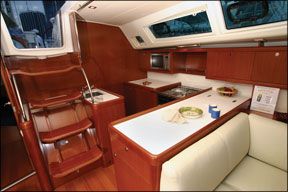In the October 2010 boat review of the Catalina 375, there was a statement regarding the location of a galley: “While some argue that the traditional port-side galley is more desirable when crossing oceans, the point is moot for a family coastal cruiser.” Is this just a whimsical nautical tradition, or is there some logic underlying it? Why is the port preferable?
I would agree that [a port galley would be favored] if most of our sailing is on a starboard tack, but the number of port and starboard tacks should be about the same.
Walt Grifel
Impromptu, Sabre 28
Key Biscayne, Fla.
As you pointed out, a port galley would be preferred on a starboard tack. While no cook likes to work when the boat is heeling sharply, it is preferable to be leaning over the stove, rather than working uphill. Aside from having to fight gravity, the leeward-leaning cook is also less vulnerable to spilled minestrone.

288
We tried to track the origins of the port-galley-is-favored argument, to no avail. We suspect this bit of trivia sprang from one of our past readings, probably written by a British author shortly after World War II, the dawn of the modern cruising era when designers and yachtsmen spent countless hours noodling over the interior arrangements for small seagoing boats. If anyone can find the citation for or against the port galley, we’d like to be reminded where it came from.
In the meantime, to settle the matter, we turned to Dave Gerr, author, yacht designer, and director of the Westlawn Institute of Marine Technology, who wrote, in good humor: “Regarding the port-side galley, I think you’ll find the location of the galley is related to the cube of the total galley counter length in inches, divided by sine of the largest angle of heel in which cooking is anticipated raised to the 1.67 power. If the whole number portion of the result is an odd number, galley to port.” In other words, it’s sheer random choice.
However, there are a few seemingly logical reasons offered why one side might be preferred on ocean-voyaging boats, which presumably will be sailing routes dictated by favorable winds. (For the typical sailor who makes short trips during the same season, your point is perfectly correct: port and starboard tacks seem fairly evenly distributed.)
A passage from California to Hawaii and certain North Atlantic migrations would favor a starboard tack, and it would be interesting to see whether a circumnavigator spends more time on one tack or another. In our experience, it is the downwind rolling that drives the cook batty, not the upwind work.
A few other considerations are right-of-way, sink drains, and throwing arms. A boat on starboard tack would technically have right of way over other sailboats, so when you are hove to or bearing offwind to make meal preparation more manageable, your boat would have right of way over most other vessels. The last thing a cook wants is to be called up for a tack while trying to build a taco.
However, our desirable port galley could cause problems for the sink drain—which, without a check valve, will tend to back-flood on a starboard tack. It also seems to work against right-handers: How are you supposed to throw apple cores out the companionway on a starboard tack and still hold on? This question will no doubt keep us occupied for some time.

































